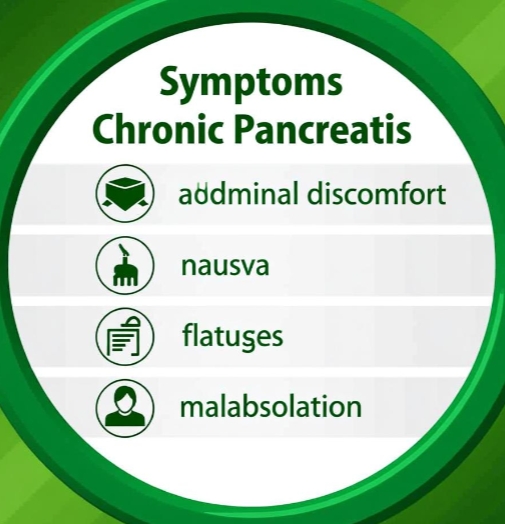Chronic pancreatitis is a persistent inflammatory-fibrosing condition of the pancreas that destroys exocrine and endocrine tissue. Onset is gradual, with pain dominating early stages and maldigestion or diabetes appearing later. Alcohol, smoking, gene variants, and obstructive causes are common triggers. Symptom recognition allows early enzyme replacement, glycaemic control, and intervention for complications.
- Pain syndromes
Epigastric boring pain: radiates straight through to the back, worse 15–30 min after eating or when lying supine; patients often lean forward or sit on the edge of the bed for relief.
Flare-ups: acute-on-chronic episodes with intensified pain, nausea, and tachycardia indistinguishable from acute pancreatitis.
Pain-free period: up to 20 % of patients, especially elderly or alcoholic, present with painless pancreatic insufficiency. - Exocrine insufficiency
Steatorrhea: bulky, pale, greasy stools that float, stick to the toilet, and have an offensive odor; typically appears when lipase secretion falls below 10 % of normal.
Weight loss: despite adequate calories, due to fat and protein maldigestion and anorexia from post-meal pain.
Bloating, loud borborygmi, and visible abdominal distension: from undigested food reaching the colon.
Fat-soluble vitamin deficiency: easy bruising (K), night blindness (A), osteopenic bone pain (D), or neuropathy (E). - Endocrine insufficiency
New-onset hyperglycaemia or brittle diabetes: occurs years after pain onset, often requiring insulin because of concomitant glucagon deficiency.
Episodic hypoglycaemia: if malnourished or after alcohol binge, due to depleted glycogen stores. - Local complications
Jaundice with dark urine and pale stools: from inflammatory stricture of the intrapancreatic bile duct.
Gastric outlet obstruction: post-prandial vomiting, early satiety, succussion splash from duodenal stenosis.
Pseudocyst or abscess: palpable upper abdominal mass, fever, or sudden increase in pain.
Splenic vein thrombosis: left-sided portal hypertension, gastrointestinal bleeding from isolated gastric varices. - Systemic and behavioral clues
Chronic fatigue, sleep inversion from nocturnal pain, and opiate dependence.
Visible nicotine staining or alcohol withdrawal tremor: indicate ongoing reversible risk factors.
Red-flag combinations demanding urgent evaluation
Continuous severe pain with tachycardia or hypotension, new jaundice, gastrointestinal bleeding, sudden palpable mass with fever, or confusion plus deep jaundice suggesting cholangitis or sepsis.
Summary table
| Symptom cluster | Typical stage | Patient first action |
|---|---|---|
| Epigastric back pain | Early | Lean forward, avoid alcohol, see specialist |
| Steatorrhea | Intermediate | Low-fat diet, pancreatic enzymes with meals |
| Weight loss | Any | Record dietary intake, request nutrition consult |
| New diabetes | Late | Monitor glucose, insulin may be needed |
| Jaundice + fever | Complication | Immediate ER for cholangitis work-up |
